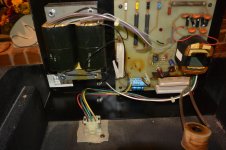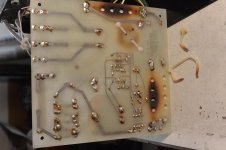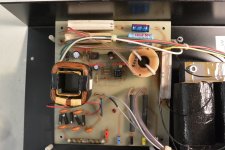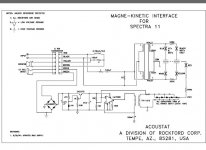The 1100's, as I plug in the transformer from the wall will sound crackling and then (as a bowl of Rice Crispies with milk just poured on them) calm down a bit. The crackling is continuous though weather a signal is applied or not. These were stored for the last 10 years in cover in my non air conditioned storage shed (I live near the old Acoustat Office in AZ). The crackling measures around 55db and the hz is around 1000 to 8000.Are the speakers making crackling noises? Does the noise occur all the time (i.e. even when no music is playing) or does it only happen when music is playing?

http://www.diyaudio.com/forums/newreply.php?do=newreply&p=5413700
The 1100's, as I plug in the transformer from the wall will sound crackling and then (as a bowl of Rice Crispies with milk just poured on them) calm down a bit. The crackling is continuous though weather a signal is applied or not. These were stored for the last 10 years in cover in my non air conditioned storage shed.....
Sounds to me like a classic case of dirt in the panel. Remedies have been discussed before in this thread. You can try de-energizing the panel (allow about an hour after being unplugged), and then with an open hand, gently bang on both sides of the panel. You might also try vacuuming the grille cloth. Re-energize. Repeat several times, if necessary, before moving onto more drastic measures.
If that doesn't work, you'll need to de-energize, pull down the grille cloth, and then thoroughly vacuum both sides of the panel. You can also use compressed air, gently, if available. This procedure may also require repeating before it's entirely effective, but it almost always works.
The good news is that the crackling does no harm to the panel, it's just annoying.
Andy,
You once had a link to a factory tour of Acoustat. Do you still have it or is it dead? There were some interesting pictures.
Jim
Those photos were once posted on the Audiocircuit website, but like most documentation I provided to them, I don't think they are available anymore. (which is why I switched to answering questions here, instead). Someday I will make a new .pdf of those photos and post here. The big task there is scanning all the slides (remember those?).
One last item to consider - when you gently pat the panel while de-energized, it has a snare drum effect as if a metal band were on the diaphragm. A few spots have unglued wires but the crackling is omnipresent on the panel. Would that change your hypothesis? I have pulled the sock down and blown is with a leaf blower several times to no effect. Next, I will vac it with a shop vac.Sounds to me like a classic case of dirt in the panel. Remedies have been discussed before in this thread. You can try de-energizing the panel (allow about an hour after being unplugged), and then with an open hand, gently bang on both sides of the panel. You might also try vacuuming the grille cloth. Re-energize. Repeat several times, if necessary, before moving onto more drastic measures.
If that doesn't work, you'll need to de-energize, pull down the grille cloth, and then thoroughly vacuum both sides of the panel. You can also use compressed air, gently, if available. This procedure may also require repeating before it's entirely effective, but it almost always works.
The good news is that the crackling does no harm to the panel, it's just annoying.
Thank you for your comments! 2bdave
Is this the pics you are thinking of?
You are my HERO. Scratch that off my list of things to do!
One last item to consider - when you gently pat the panel while de-energized, it has a snare drum effect as if a metal band were on the diaphragm. A few spots have unglued wires but the crackling is omnipresent on the panel. Would that change your hypothesis? I have pulled the sock down and blown is with a leaf blower several times to no effect. Next, I will vac it with a shop vac.
Thank you for your comments! 2bdave
A few unglued spots are okay, as long as the wire(s) are not rattling, or raised up such that they are too close to the diaphragm. If they are, there is little you can do to fix that (although you can try, as there's little to lose at that point). But try to get the panel CLEAN first.
The "snare drum" effect is somewhat bothersome, as it suggests the diaphragm is hitting something, like a foreign object (dirt, insect parts, stray bit of plastic, etc.) or a loose wire.
Not sure if the leaf blower is a great idea. Not only can it blow more dirt into the panel, it's not really the concentrated stream like you would get from a proper compressed air system. Vacuum, vacuum, vacuum.
To 2bdave:
Another distinct possibility is that the diaphragm has lost its proper tension, which may also be causing the "snare drum" effect.
After a complete cleaning, and if you still have a problem, you can re-shrink the Mylar with an industrial heat gun (most hair driers aren't good enough). Working from the front of the de-energized panel, position the heatgun about 4-5" away from the panel, and keep it constantly moving back-n-forth and up-n-down. The idea is to slowly heat the diaphragm, without concentrating the heat in any one area. This is best approached incrementally, heating the Mylar some, testing, heating some more, etc., until the rattle disappears. Patience is the key, as too much heat can melt the Mylar, and then your panel is a goner.
Another distinct possibility is that the diaphragm has lost its proper tension, which may also be causing the "snare drum" effect.
After a complete cleaning, and if you still have a problem, you can re-shrink the Mylar with an industrial heat gun (most hair driers aren't good enough). Working from the front of the de-energized panel, position the heatgun about 4-5" away from the panel, and keep it constantly moving back-n-forth and up-n-down. The idea is to slowly heat the diaphragm, without concentrating the heat in any one area. This is best approached incrementally, heating the Mylar some, testing, heating some more, etc., until the rattle disappears. Patience is the key, as too much heat can melt the Mylar, and then your panel is a goner.
Hey Andy, used my wife's hair dryer and the first pass made a distinctive improvement. I'll pull the felt off and make another pass later. That's what it was!To 2bdave:
Another distinct possibility is that the diaphragm has lost its proper tension, which may also be causing the "snare drum" effect.
After a complete cleaning, and if you still have a problem, you can re-shrink the Mylar with an industrial heat gun (most hair driers aren't good enough). Working from the front of the de-energized panel, position the heatgun about 4-5" away from the panel, and keep it constantly moving back-n-forth and up-n-down. The idea is to slowly heat the diaphragm, without concentrating the heat in any one area. This is best approached incrementally, heating the Mylar some, testing, heating some more, etc., until the rattle disappears. Patience is the key, as too much heat can melt the Mylar, and then your panel is a goner.
Thank you for the info!
2bdave
Hey Andy, used my wife's hair dryer and the first pass made a distinctive improvement. I'll pull the felt off and make another pass later. That's what it was!
Thank you for the info!
2bdave
No need to remove the felt. You can do all the heating from the front.
Acoustat 1+1 stupid question
I asked this over at AK and was directed here.
I was re-routing a bunch of cables and fired up my new to me Acoustat 1+1 with Mk-121-b interfaces.
I realized my mains wrre disconnected on the left channel.
But they were playing the same as the right channel.
Do they hold a charge?
If so how quickly does it disapate when played?
My amp is a MAC1900 and is only 55wpc.
Thanks
Ray
I asked this over at AK and was directed here.
I was re-routing a bunch of cables and fired up my new to me Acoustat 1+1 with Mk-121-b interfaces.
I realized my mains wrre disconnected on the left channel.
But they were playing the same as the right channel.
Do they hold a charge?
If so how quickly does it disapate when played?
My amp is a MAC1900 and is only 55wpc.
Thanks
Ray
I asked this over at AK and was directed here.
I was re-routing a bunch of cables and fired up my new to me Acoustat 1+1 with Mk-121-b interfaces.
I realized my mains wrre disconnected on the left channel.
But they were playing the same as the right channel.
Do they hold a charge?
If so how quickly does it disapate when played
My amp is a MAC1900 and is only 55wpc.
Thanks
Ray
Yes, the panels do remain charged for a while after removal of mains voltage. How long will depend on many factors, including relative humidity, condition of panels, and how loud you are playing them in that state.
No real harm was done. Plug-in the speakers and enjoy! Acoustat always recommended that the speakers be energized at all times: the power consumption is minimal. What's "AK"?
Last edited:
AK=Audio Karma, a hi-fi forum.
I ran them a minute or so.
I may have had the volume knob around "7"
I am going to rebuild the bias supplies tonight.
I had a concern that the bias' may have been bad as one was plugged in and one wasn't and both had the same output.
So I measured between stages in the bias and got 385v each stage and figure my output to be about 1.2kv mo where near 5kv.
Good to know I haven't done them harm.
I would love to push them harder. Vocals sound magical through these speakers.
Thanks.
Ray.
I ran them a minute or so.
I may have had the volume knob around "7"
I am going to rebuild the bias supplies tonight.
I had a concern that the bias' may have been bad as one was plugged in and one wasn't and both had the same output.
So I measured between stages in the bias and got 385v each stage and figure my output to be about 1.2kv mo where near 5kv.
Good to know I haven't done them harm.
I would love to push them harder. Vocals sound magical through these speakers.
Thanks.
Ray.
If you are attempting to measure with an ordinary meter, your measurements are likely much lower than actual. I've attached a document that talks about measuring the bias voltage. It also talks about adjusting the voltage, which doesn't apply to your 1+1's.
Your supply might benefit from new multiplier caps, or even diodes, but I doubt you are getting that low a bias voltage.
Your supply might benefit from new multiplier caps, or even diodes, but I doubt you are getting that low a bias voltage.
Attachments
Spectra 11 maintenance.
I have removed the panel and interface from my spectra 11. The board has been cooked!. Is this from cranking them too much, or using the wrong type amplifier, or? The speakers still seem to be working OK.
1. As found. The 10ohm 20W has cracked open. It measured 11.9 ohms.
2. The backside of the board.
3. I re-mounted the inductor and glued the piece of broken ceramic with heatsink epoxy. The electrolytic caps are labeled for those that want to replace them.
Are there any recommended upgrades? I was thinking of bypassing the 2 crossover caps with some small (5uF ?) film caps.
I have removed the panel and interface from my spectra 11. The board has been cooked!. Is this from cranking them too much, or using the wrong type amplifier, or? The speakers still seem to be working OK.
1. As found. The 10ohm 20W has cracked open. It measured 11.9 ohms.
2. The backside of the board.
3. I re-mounted the inductor and glued the piece of broken ceramic with heatsink epoxy. The electrolytic caps are labeled for those that want to replace them.
Are there any recommended upgrades? I was thinking of bypassing the 2 crossover caps with some small (5uF ?) film caps.
Attachments
- Home
- Loudspeakers
- Planars & Exotics
- Acoustat Answer Man is here



